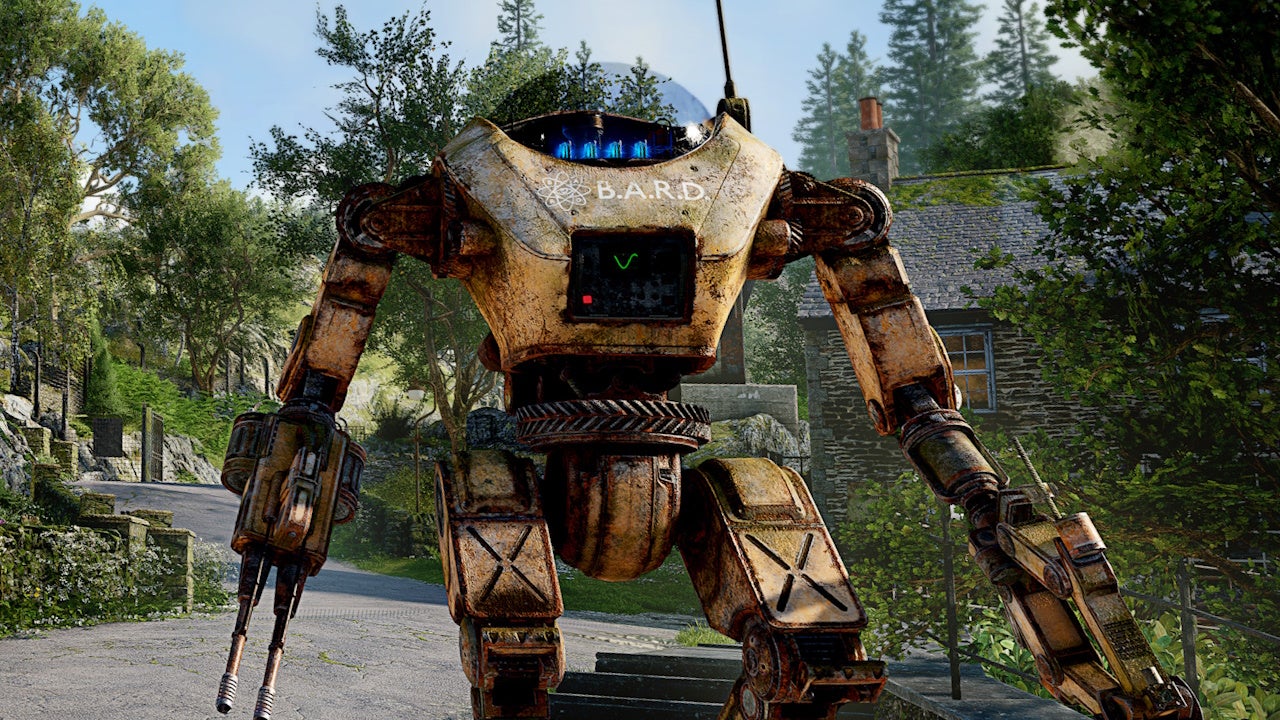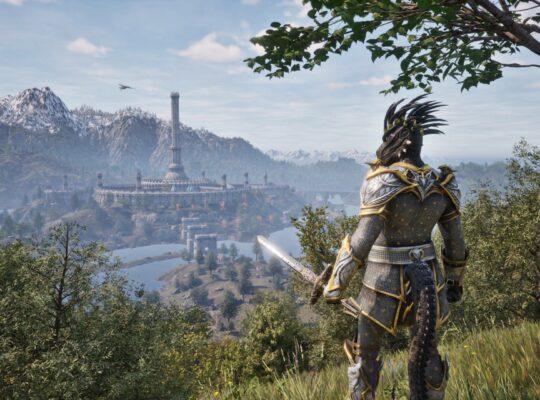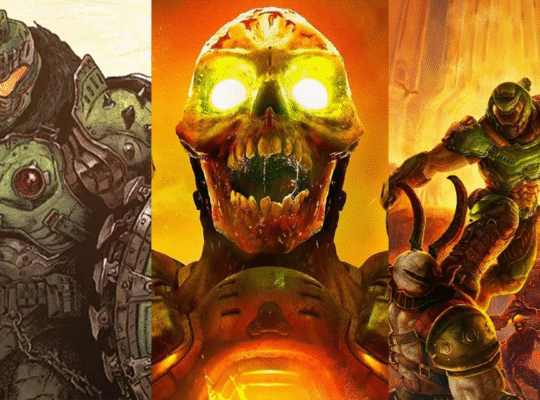When Atomfall was announced as part of the Xbox Games Showcase earlier this summer, its first-person, post-apocalypse, alt-history design made it appear that developer Rebellion was crafting a British version of Fallout. And, for a while, that’s (sort of) what it was building. But the team at Rebellion soon realised that a story driven by traditional RPG quests just wasn’t what they wanted to make. They hoped for something much, much more interesting. The solution was to replace quests with ‘leads’, transforming Atomfall into what’s probably best described as a ‘detective survival game’. Here’s how that all works.
My hands-on demo begins with the UK’s iconic red telephone box. One stands alone amid the verdant, picturesque English countryside (Atomfall’s beautiful Cumbria is a far cry from the irradiated wastes of Fallout). Its phone is ringing. I pick up the receiver and hear a mysterious voice. “Oberon must die,” it tells me, before hanging up. A UI prompt tells me a lead has been added to my journal. It’s not a quest, but a question.
Atomfall is full of questions. Who is Oberon? And why must he die? Why can’t you remember who you are? What is Interchange, and how is it connected to the Windscale event (a fictionalised version of a real 1957 nuclear disaster) in northern England? Why does a vicar desperately not want you to investigate a murder? Why is an army captain so obsessed with the local baker? Each person you speak to adds more and more leads, and more and more questions, to your journal. Follow those leads and you’ll find answers… as well as more questions. Questions are all you have when waking up with amnesia, after all.
Hanging up the phone, I walk down through a hilly valley and bump into a local chap named Nat Buckshaw. Our conversation initially reminds me of those in Fallout (particularly New Vegas) as each response is categorised by tags such as ‘friendly’, ‘suspicious’, or ‘desperate’. But these are not attached to skills – you don’t need +8 in charisma to charm anyone in Atomfall as your character is naturally flexible during dialogue. So instead of feeling like an RPG, this conversation reminds me a little of L.A. Noire – a game where you judge a person’s demeanour and choose responses based on their reactions rather than your character’s stat build.
Each dialogue response is categorised by tags such as ‘friendly’ or ‘suspicious’, but you don’t need +8 in charisma to charm anyone.
With Nat, it quickly becomes clear he enjoys running his mouth off, so I stay pleasant (and play up my amnesia a little) in hope he’ll spill some beans. He soon slips up and reveals that the region is full of secret bunkers (“or so I’ve heard”), but insists the entire area is abandoned aside from some outlaws. A little more chat later, he absentmindedly reveals that there’s a village called Wyndham to the north. Seems like this place isn’t so abandoned, after all. New leads are added to my journal – the ‘rumoured village’ is added to the map, as well as an objective to track down Molly, a woman who Nat suggests might be able to help answer my mounting questions.
Between Nat and Wyndham is a whole district that feels something like a hybrid of Bethesda’s point-of-interest-filled open worlds and the large, play-your-own-way maps of Rebellion’s Sniper Elite games. As I head north in search of the village I find abandoned buildings and one of those secret bunkers filled with the usual bits of string, gunpowder, and cans of off-brand Spam you’d expect of a game with a survival-inspired crafting system. I quickly notice that bullets are only found in ones and twos rather than full magazines, and that my weapon – a filthy, rusted revolver – has just three rounds in it. It seems like Atomfall is a game of desperate endurance, one where a single bullet could be the most valuable thing you own. Well, the most valuable physical thing – the leads-based structure suggests that information is actually your most prized possession.
I soon come across a gang of patrolling outlaws armed with rifles and cricket bats. With just those three bullets to my name, I decide to take a stealthy approach, sticking to cover and carefully inching my way through the area. Keeping quiet is somewhat similar to how it works in Far Cry – there’s plenty of long grass to hide in, HUD indicators for enemy alertness, and takedown prompts when sneaking up on foes from behind. Finding gaps in patrols and choking out enemies feels as fun as it generally does in these sorts of games, but this time around I loot a health-replenishing Cornish pasty from the corpse. Atomfall’s definitely British, alright.
Rebellion’s associate head of design, Ben Fisher, tells me that the entire game can be played without killing a single soul. And, if the demo’s combat proves representative of the final game due to be released in March 2025, that’ll likely be the approach I attempt to take. Direct clashes seem less satisfying than the alternate options. My stealth mission is busted by a keen-eyed outlaw and I find myself in a desperate brawl, clumsily beating goons over the noggin with my looted cricket bat. Atomfall’s melee combat isn’t bad, but it does feel unrefined and choppy, and its heart rate-tracking stamina system (a nod back to Sniper Elite) means I’m quickly winded between blows. Switching to my pistol, I appreciate how lethal it is – this isn’t a game where violence should be taken lightly – but the blast doesn’t quite have the punch I’d like. There’s plenty of time for Rebellion to tighten all this up (plus tweak the enemy AI, which seems simply adequate right now), but Atomfall’s combat currently seems its weakest and least interesting element. I hope, in a full playthrough, it doesn’t feel like fighting gets in the way of all the exploration, lead chasing, and sneaking.
Wyndham is a picture-perfect village made unnerving by the presence of a patrolling killer robot.
Adopting a more vigilant stealth approach and sticking to abandoned pathways, I soon make it to Wyndham. It’s a picture-perfect village made unnerving by the presence of a patrolling killer robot and a squadron of soldiers from ‘Protocol’. I’m instructed to meet with their leader, Captain Sims, who stands in the village square reprimanding the locals about their practising of “barbaric” paganism. My conversation with him is much more straightforward than my earlier dialogue with Nat; Sims refuses to cooperate with me unless I do some dirty work for Protocol. He’s convinced Iris, the village baker, is up to no good. And so, in the name of finding out more about Oberon and Interchange and why exactly there’s a military-occupied, walled-off village in what seems to be a nuclear quarantine zone, I agree to become a temporary spy/gossipmonger.
At the bakery, my chat with Iris is entirely unremarkable – she certainly doesn’t seem the shady sort. But I do what twenty years of playing Bethesda games has taught me to do and go rifling through the back of her shop. I soon find that her bedroom door is locked. What is she hiding? A nearby letter reveals that the key has been given to Tina, an employee of the village garage, who has agreed to look after the bakery while Iris tends to some troubles. And so I hoof it over to the garage, break in, and swipe the key. Lying with it is another note that reveals the truth of the situation – Iris’ husband has been stricken by disease thanks to the nuclear disaster, and seems to be slowly transforming into a mutant. Protocol will surely kill him, and so Iris needs Tina’s help to cover for her.
It’s a classic moral dilemma; what will I do with this information? Do I pass it on to Sims, who will hopefully reveal more of the mystery behind the disaster? Could I perhaps use it to extort Iris and Tina? Do I break into the bedroom and assassinate the husband who presumably is hidden inside, ‘protecting’ Wyndham from a feral menace?
The demo ends before I’m able to work out my options, never mind make my choice. But it’s the freedom to choose how I navigate Atomfall’s network of leads, all of which potentially inch me towards answering this world’s many questions, that has me very excited about Rebellion’s most unusual project in a decade. Fisher tells me that there are a multitude of ways to discover the answer to the game’s central, burning question of ‘What exactly happened here?’ So many, in fact, that you could have at least a couple of broadly different playthroughs. You can apparently even kill every character in the game and still be able to find clues within the environment that will lead you to that final answer. If Atomfall truly does prove that flexible and intricate, then the Sniper Elite developers may have finally found something cooler than a slow-motion, x-ray vision, right-between-the-eyes headshot.
Matt Purslow is IGN’s Senior Features Editor.










